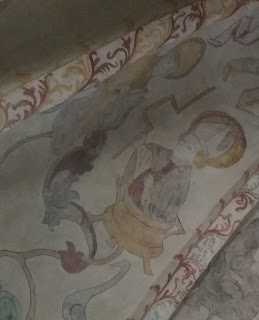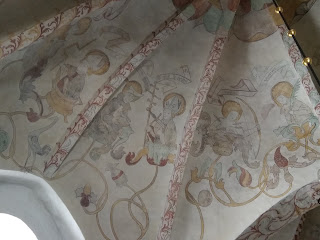One of my various side-projects these days entails a revisit to the saints of the Church of Our Lady in Skive in Northern Jutland. The church, built around 1200, was decorated with an extensive wall-painting programme of various saints in 1522, and thanks to restoration work in the 1900s, most of these can still be seen today. I have touched upon several of these saints in earlier blogposts (see here, here, here, here, and here). The best treatment of these wall-paintings can be found in a small pamphlet from 1993, Kalkmalerierne i Vor Frue Kirke Skive (The frescoes of the Church of Our Lady, Skive), published by Bodil Glad and Ingvar Glad in 1993. Having read through this excellent resource, I was notified of one particular and in a way delightful detail that I had caught on camera during my visit there in 2019, but which I had subsequently overlooked - no doubt distracted by the host of other details to draw the eye.
The detail in question concerns the representation of Saint Erasmus, also known as Saint Elmo, whom we find in the second vaulting of the nave next to Saint Denis, or Dionysius if one prefers. Saint Erasmus was, according to legend, the bishop of Formia, who was martyred in a typically gruesome fashion: He had his entrails drawn out with a windlass, and he was himself boiled in a pot. As is typical in medieval Christian art, the martyr Erasmus is depicted holding one of the (often several) instruments of his torture, in this case the windlass. Among the other saints in Skive we see the same pattern, although some have other symbols of their martyrdom than the instruments, such as Erasmus' neighbour Denis, who holds the top of his skull, which his assailants chopped off.
In the case of Saint Erasmus, however, the artist has decided to present the legend of the saint by more ways than one. Possibly inspired by the vogue of the time which had saints emerge from flower bulbs, the artist has replaced the bulb with the pot from Saint Erasmus' passion, making the saint stand out among his colleagues, as can be seen in the second of the blogpost's two images. The reason for this choice is unknown to us, and can be interpreted in several ways. Was it a humorous choice? Or did it grow - pun intended - out of devotion for the saint, resulting from a wish to make Erasmus more notable, or to have his legend represented in more detail? Did it follow a wider trend of the period, a period in which Erasmus enjoyed widespread popularity as one of the fourteen holy helpers? Ultimately we do not know, but we can still enjoy the result of this decision taken during the work of 1522.
And was the holy Lamb of God,
On Englands pleasant pastures seen!
- And did those feet, William Blake
On Englands pleasant pastures seen!
- And did those feet, William Blake
tirsdag 25. januar 2022
The saint in the pot - Saint Erasmus at Skive
Saint Erasmus in a pot, next to Saint Denis with the top of his skull
Saint Erasmus in immediate context
(Denis, Erasmus, Peter Martyr, Thomas of Canterbury, Sebastian and Vincent)
Abonner på:
Legg inn kommentarer (Atom)


Ingen kommentarer:
Legg inn en kommentar